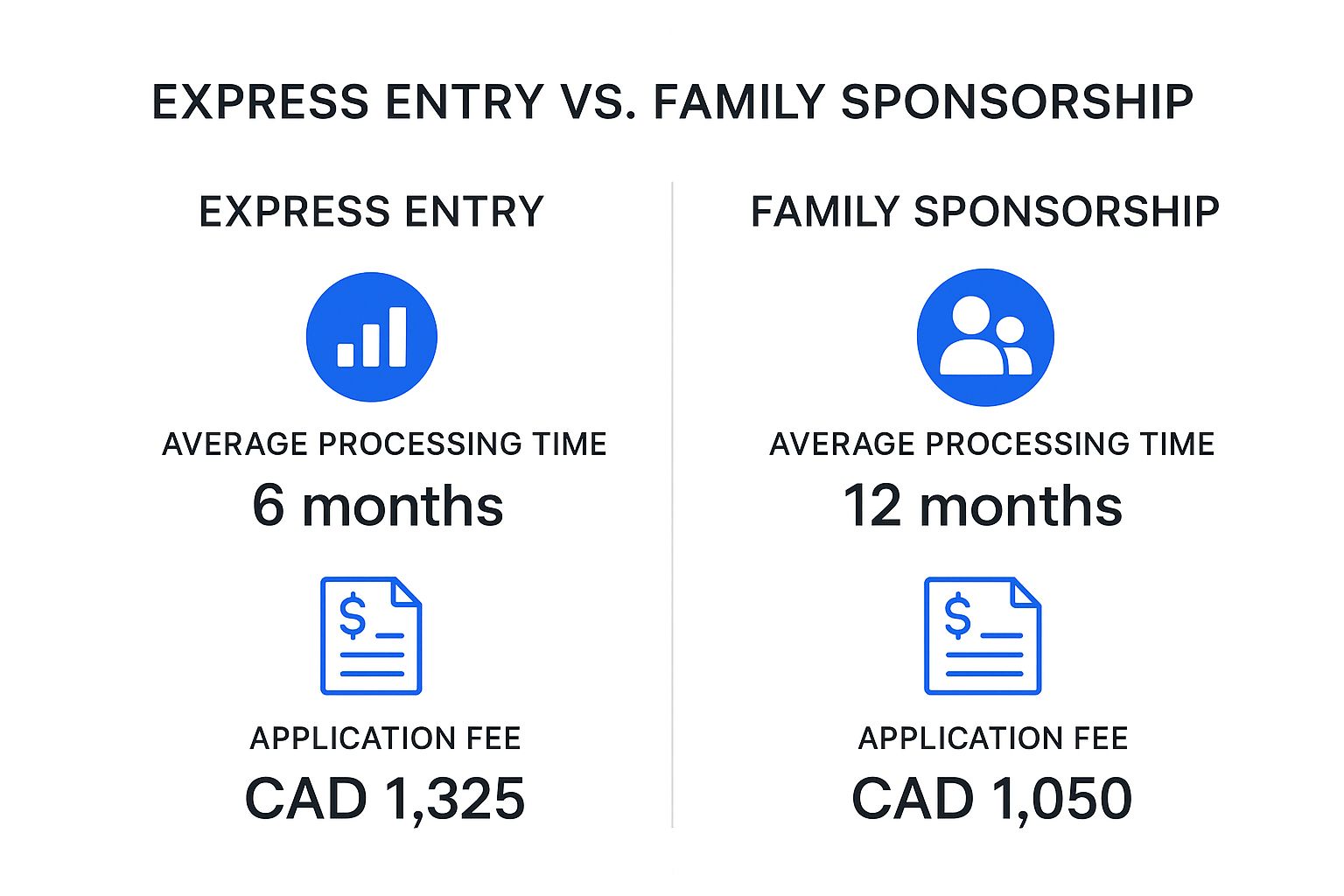Canadian Permanent Residency Application: Your Step-by-Step Guide

Navigating the Pathways to Canadian Permanent Residency
Canada offers a variety of pathways to permanent residency (PR), each tailored to different situations. Understanding these options is the first critical step in your application journey. This section will clarify these pathways, helping you determine the best route for your individual profile.
Exploring Your Options
The most common pathway is Express Entry, a points-based system managing applications for three primary economic immigration programs:
- Federal Skilled Worker Program (FSWP): For skilled workers with foreign work experience.
- Federal Skilled Trades Program (FSTP): For skilled tradespeople with specific qualifications.
- Canadian Experience Class (CEC): For skilled workers with Canadian work experience.
Express Entry utilizes the Comprehensive Ranking System (CRS) to evaluate and rank candidates. This system awards points based on factors like age, education, language skills, work experience, and adaptability. Higher CRS scores improve your chances of receiving an Invitation to Apply (ITA) for permanent residency.
Beyond Express Entry, Provincial Nominee Programs (PNPs) offer another avenue to PR. These programs enable provinces and territories to nominate individuals who fulfill their specific economic and labor market requirements. A provincial nomination can significantly enhance your CRS score, improving your chances of an ITA. For those seeking PR from Nigeria, understanding the individual needs of each province can be particularly beneficial.
Family sponsorship allows Canadian citizens and permanent residents to sponsor eligible family members to immigrate. This option prioritizes family reunification, offering a pathway for those with close relatives already in Canada.
Choosing the Right Pathway
The best pathway depends on your qualifications, work history, and family connections in Canada. For instance, the FSWP under Express Entry might be suitable for applicants with extensive skilled work experience outside Canada. However, for those with Canadian work experience, the CEC may be more strategic.
Navigating these options can be challenging. Canadian immigration statistics reveal the complexities of permanent residency applications. Statistics Canada provides further insight into these trends, which are influenced by various factors, including fluctuations in non-permanent residents, and inform the government’s annual immigration targets.
Understanding processing times is also essential. While some programs offer quicker processing, others may have longer wait times. Researching current processing times for each pathway will help you make a well-informed decision aligned with your timeline. Carefully evaluating your profile against each program’s eligibility criteria will guide you toward the optimal Canadian permanent residency application pathway.
Mastering The Eligibility Requirements For Your PR Journey

Moving beyond the basic criteria, a successful Canadian permanent residency application often hinges on a deep understanding of the details. This section explores these finer points, equipping you with the knowledge to optimize your application for Canadian permanent residency.
Decoding The Comprehensive Ranking System (CRS)
The Comprehensive Ranking System (CRS) forms the core of the Express Entry system. It’s a points-based system used to assess and rank candidates. Several factors are considered, ultimately determining your chances of receiving an Invitation to Apply (ITA). Learn more about improving your score: How to master your CRS score.
The CRS considers factors such as age, education, language proficiency, work experience, and adaptability. Younger applicants generally receive more points. Higher education levels also significantly contribute to a higher score.
Maximizing Your CRS Score: Strategic Steps
A higher CRS score significantly increases your chances of receiving an ITA. One key strategy is to improve your language proficiency. Even a small improvement in your English or French test scores can significantly boost your overall points. A thorough evaluation of your educational credentials is also crucial to ensure you receive the maximum points possible.
Canadian work experience is another important factor. Even one year of skilled work in Canada can substantially increase your score. Gaining Canadian work experience before applying can greatly strengthen your application.
Recent policy changes emphasize specific in-demand occupations. Identifying these and highlighting them in your application can give you a competitive edge and potentially fast-track your application process.
To help you understand the points breakdown, let’s look at the following table:
Express Entry Points Breakdown
A comprehensive breakdown of how points are allocated in the Comprehensive Ranking System (CRS) for Express Entry applications.
| Factor | Maximum Points | Details |
|---|---|---|
| Age | 110 | Points are awarded based on age, with the highest points awarded to applicants in their late 20s. |
| Education | 150 | Points are awarded for completed educational credentials, with higher points for higher levels of education (e.g., master’s degree, doctoral degree). |
| Language Proficiency | 160 | Points are awarded for proficiency in English or French, based on standardized test scores (e.g., IELTS, CELPIP, TEF). |
| Work Experience | 100 | Points are awarded for skilled work experience, both inside and outside Canada. More points are awarded for longer periods of experience. |
| Adaptability | 100 | Points are awarded for factors that demonstrate adaptability to Canadian life, such as a spouse or common-law partner’s language proficiency, Canadian education, or previous work experience in Canada. |
| Spouse or Common-law Partner Factors | 40 | Points awarded based on a spouse or common-law partner’s language proficiency, education, and Canadian work experience |
| Canadian Work Experience and Education | Not Stated | Points are significantly higher with a combination of Canadian work experience and education and help demonstrate your fit and ability to thrive within the Canadian workforce and society. |
This table summarizes the key factors influencing your CRS score. Maximizing points in each category significantly improves your chances of receiving an ITA.
Exploring Family Sponsorship And Provincial Criteria
Family sponsorship applications have specific financial requirements. The sponsor must demonstrate they have sufficient funds to support their family members upon arrival in Canada. A clear understanding of these requirements is crucial for a successful application.
Beyond Express Entry, Provincial Nominee Programs (PNPs) offer another pathway to Canadian permanent residency. Each province has its own specific criteria. Researching these programs can reveal opportunities aligned with your skills and experience, potentially offering a faster route to PR. Some provinces actively seek specific professions, creating an advantage for applicants in those fields. Thorough research into each province’s needs is vital for aligning your application accordingly. Meeting specific provincial criteria can often expedite your application and increase your likelihood of success.
The Step-by-Step Roadmap to PR Application Success

Successfully obtaining Canadian permanent residency requires careful planning and thorough execution. This roadmap will guide you through each stage, from creating your initial profile to responding to any requests for more information. For further reading, check out this helpful guide: How to master your Canadian PR application.
Creating Your Online Profile: The Foundation
The first step involves creating an online profile via the Express Entry system. You’ll need to provide accurate personal information, employment history, educational background, and language test scores. Consider this profile as your digital resume, presenting your qualifications to Canadian immigration officials. Accuracy is critical, as any discrepancies could lead to delays or rejection.
Responding to Your Invitation to Apply (ITA)
Receiving an Invitation to Apply (ITA) is a major step. It signifies you’ve been chosen from the Express Entry pool and are eligible to formally apply for permanent residency. However, an ITA isn’t a guarantee of approval; it simply allows you to move to the next stage. You’ll have a limited timeframe (typically 60 days) to submit your complete application, highlighting the importance of preparation and organization.
Organizing Your Documentation Strategically
Your documentation forms the core of your application. Meticulous gathering and organization are essential for a smooth process. Required documents include your passport, educational credentials, work experience letters, language test results, police certificates, and medical exam results. Understanding the legal framework for documentation is crucial. For example, you can find useful information regarding legal guidelines for employee background checks in India. Ensure all documents are accurately translated and authenticated as needed.
Practical Timelines and Tracking Your Application
Each stage of the PR application process has specific timelines. Medical exams and biometrics appointments should be scheduled strategically to avoid potential delays. Regularly tracking your application’s progress after submission is key. The IRCC provides online tools to monitor your application status. The Canadian government strives for processing efficiency. Recent data indicates the IRCC processed approximately 55% of permanent residency applications (472,600 out of 852,700) within service standards. More detailed statistics are available here.
Responding to Additional Information Requests
The IRCC may request additional information or documentation. Responding promptly and comprehensively is crucial to prevent delays. This stage requires careful attention to detail, ensuring all requested information is accurate and easily accessible. This proactive approach will help keep your application progressing smoothly. Ultimately, understanding and following each step diligently increases your chances of successfully becoming a Canadian permanent resident.
Documentation Mastery: Building Your Winning Application

The Canadian permanent residency application process depends heavily on accurate and complete documentation. This section explores how to prepare a strong application package, ensuring your documents meet the specific requirements of Canadian immigration authorities.
Obtaining and Authenticating International Documents
Gathering documents from different countries can be complicated, particularly for Nigerians applying for Canadian permanent residency. Begin the process early and anticipate potential delays. For example, obtaining police certificates from Nigeria can involve navigating complex bureaucratic procedures.
Ensure all your credentials are correctly authenticated. This often includes notarization and legalization by the appropriate authorities, validating your documents for the Canadian government. For academic credentials, an Educational Credential Assessment (ECA) is required. An ECA demonstrates that your international education is comparable to a Canadian qualification.
Showcasing Your Work Experience Effectively
Presenting your work experience persuasively is essential. Instead of simply listing your duties, emphasize your accomplishments and quantifiable results. Consider how your experience aligns with the specific requirements of the Canadian permanent residency program you are applying for.
For example, if applying under the Federal Skilled Worker Program, demonstrate how your skills and experience meet the needs of the Canadian labor market. Highlight specific projects and quantify your contributions whenever possible.
The Power of Compelling Reference Letters
Strong reference letters can significantly strengthen your application. These letters should go beyond confirming your employment history. They should showcase your skills, abilities, and character. Choose referees who can speak to your strengths and provide concrete examples of your achievements. A well-written reference letter offers valuable third-party validation.
Handling Missing or Unavailable Documents
Sometimes, documents might be unavailable due to unforeseen circumstances. If this occurs, provide a clear and concise explanation. Include any alternative documentation that supports your claims. This demonstrates transparency and addresses potential concerns from immigration officials, preventing unnecessary delays or rejection.
Translating Foreign Documents: Ensuring Accuracy
All documents not in English or French require certified translations. These translations must be accurate and complete, faithfully reflecting the original document’s content. Using a certified translator ensures the translation meets the required standards of Canadian immigration authorities.
Digital Organization: Streamlining Your Application
Managing numerous documents can be challenging. Use a digital organization system to maintain order and accessibility. This could involve creating digital folders, utilizing cloud storage services, or using document management software.
A well-organized system allows you to quickly locate any document, streamlining the entire application process. This meticulous approach minimizes errors and demonstrates attention to detail, which is essential for a successful Canadian permanent residency application.
Strategic Provincial Selection for Long-Term Success
Your Canadian permanent residency application destination significantly impacts your approval odds and how easily you integrate. Provincial programs have different nomination criteria, processing times, and newcomer retention rates. Choosing wisely sets you up for long-term success.
Matching Your Profile to the Right Province
Some provinces prioritize in-demand occupations. For example, skilled tradespeople might find more opportunities in provinces facing labor shortages in those areas. You might be interested in: Manitoba Provincial Nomination. Language proficiency also plays a key role. Fluency in English and French may give you an advantage in some provinces.
To help you understand the differences between Provincial Nominee Programs (PNPs), we’ve compiled the following table:
Provincial Nominee Programs Comparison: A comparison of key features, requirements, and processing times for major Provincial Nominee Programs across Canada
| Province | Program Streams | Target Occupations | Processing Time | Minimum Requirements |
|---|---|---|---|---|
| Ontario | Express Entry, Human Capital Priorities Stream, Skilled Trades Stream | Tech, Healthcare, Skilled Trades | 2-3 months | Varies by stream |
| British Columbia | Skills Immigration, Express Entry BC | Tech, Healthcare, Business | 2-4 months | Varies by stream |
| Alberta | Express Entry, Alberta Opportunity Stream | Tech, Healthcare, Engineering | 3-6 months | Varies by stream |
| Manitoba | Skilled Worker Overseas, Skilled Worker in Manitoba | Healthcare, Manufacturing, Skilled Trades | 4-6 months | Varies by stream |
| Quebec | Quebec Skilled Worker Program | Healthcare, IT, Engineering | 6-12 months | French language proficiency often required |
This table provides a simplified overview. Specific requirements and processing times can vary.
Understanding the key differences between PNP streams can greatly influence your application strategy.
Factors Beyond the Application: Housing, Employment, and Quality of Life
Beyond the application, consider long-term factors like housing, employment, and quality of life. Housing costs differ significantly across Canada. Metropolitan areas like Toronto and Vancouver offer abundant job opportunities, but living expenses are high. Smaller cities might have more affordable housing, but fewer jobs in specific fields.
Employment opportunities also vary regionally. Research provincial job markets to see if your skills are in demand. This helps streamline your job search after becoming a permanent resident.
Finally, factor in your family situation. Some provinces have stronger educational systems or better healthcare access, especially important for families with children or elderly relatives.

The infographic above compares Express Entry and Family Sponsorship, showing differences in processing times (6 months vs. 12 months) and application fees (CAD 1,325 vs. CAD 1,050). While family sponsorship has a lower fee, it takes significantly longer than Express Entry. Creating effective forms is key. A drag-and-drop HTML form builder can simplify this process.
The Importance of Retention Rates
Provincial retention rates reveal how many immigrants stay after receiving permanent residency. Ontario, British Columbia, and Alberta have high retention rates, with Ontario leading at 93.7%. The Atlantic provinces have lower rates, Nova Scotia highest at 62.8%. This data, coupled with how family sponsorship impacts retention (family-sponsored immigrants often stay longer), informs regional planning. Learn more about immigrant retention rates in Canada.
Making an Informed Choice for Your Future
Choosing the right province is a crucial step. It affects not only your application but also your long-term well-being and success in Canada. Careful consideration of these factors helps you make a choice aligned with your goals, leading to a fulfilling life in your new home.
Insider Strategies for PR Application Approval
Securing Canadian permanent residency is more than just checking boxes. It demands a strategic approach. This section explores insider strategies from immigration professionals and successful applicants to help maximize your chances of approval.
Boosting Your CRS Score: When Every Point Counts
If your Comprehensive Ranking System (CRS) score is close to the cut-off, strategic improvements can be the deciding factor. Think of your CRS score like a competitive game – every point matters. Retaking language proficiency tests like IELTS or CELPIP can often result in a higher score. Even a few extra points can significantly improve your ranking.
Additionally, explore educational pathways that offer the most points. A Master’s degree typically earns more points than a Bachelor’s degree. However, certain certifications or diplomas in in-demand occupations can also provide valuable points. Strategically choosing these options can bring you closer to the Invitation to Apply (ITA) threshold.
Addressing Potential Application Issues Proactively
Your application is like a complex machine – every part needs to function flawlessly. Inconsistencies between your stated experience and supporting documents are warning signs for immigration officers. These inconsistencies can cause closer examination, leading to delays or rejection. Carefully review your application for any discrepancies and address them in advance.
For example, if your work experience letter doesn’t perfectly match your job title or duties in your application, get clarification from your former employer. This proactive step shows attention to detail and strengthens your application’s credibility.
Professional Representation vs. Self-Representation
Many applicants debate whether to hire an immigration consultant. It’s like deciding whether to fix your car yourself – you can handle minor repairs, but complex issues require a professional mechanic. Similarly, while self-representation is an option, professional representation can be essential, especially for complicated cases.
A legitimate consultant provides expert guidance, identifies potential problems, and ensures your application is complete and compliant. Verify a consultant’s credentials by checking if they are registered with the Immigration Consultants of Canada Regulatory Council (ICCRC). This protects you from unqualified practitioners and ensures you receive proper advice.
Maintaining Legal Status and Handling Changes in Circumstances
Maintaining valid legal status in Canada during the application process is crucial. This requires ensuring your temporary visa or permit remains valid. If your work permit is expiring, apply for an extension well in advance to prevent a lapse in your status.
Life is unpredictable, and your circumstances may change during the application process. Changes like a new job, marriage, or having a child must be reported to IRCC promptly to keep your application accurate. Failing to report these changes can create complications and even jeopardize your application.
By understanding these insider strategies, you can approach the Canadian permanent residency application process with confidence and improve your chances of approval.
Ready to start your Canadian immigration journey? JapaChat, an AI immigration expert platform, offers personalized guidance and support. Start your journey with JapaChat today!

Leave a Reply